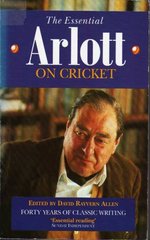The Essential Arlott on Cricket
David Taylor |Published: 1989
Pages: 320
Author: Allen, David Rayvern (Editor)
Publisher: Willow Books
Rating: 4 stars

Leslie Thomas John Arlott, OBE, was born 100 years ago this year, and has been gone nearly two decades. You have to be of a certain age now to remember his unique voice on the radio – although plenty has been saved for the archives – and it occurs to me that many more casual fans, although they enjoyed listening to him commentate on the cricket, may have been unaware that he was a writer too. In fact Arlott wrote prolifically, and up to the end of his life – the 1992 Wisden may be unique in carrying a piece (his annual book review section) by someone whose obituary was also included. This anthology, compiled towards the end of his life by his biographer David Rayvern Allen (Arlott contributes a short Preface) collects a wide variety of his work over more than forty years.
The book is divided into thirteen chapters of varying lengths. ‘International Figures’ and ‘Test Grounds’ are self-explanatory, but what of the cryptic ‘Three from Three Makes Nine?’ I confess myself baffled. There are nine pieces though, taken mostly from benefit brochures and county yearbooks. Arlott, with a tremendous capacity for work – and one who, I suspect, very much considered himself a writer first and foremost – would write for any professional cricketer if asked. He was the president of the PCA from 1968 until his death – something he considered a great honour.
While he wrote with feeling on the county game, much as Neville Cardus, whom he much admired, had done before, Arlott made his name early on with tour books – ‘Indian Summer’ recorded the visit of the first touring side after the war to England, led by former England batsman the Nawab of Pataudi, and was followed in successive years by ‘Gone to the Cricket’ and ‘Gone to the Test Match’ – accounts of the series against South Africa and the ‘invincible’ Australians. Perhaps it is time for an example of his work – this comes from his 1958 obituary of Phil Mead.
Two Hampshire wickets would fall and then he would walk out, bat tucked under his right arm, carefully pulling on his gloves; his cap was set very straight above his long face. He had a rolling, self-reliant walk, powerful drooping shoulders, long, heavy, thick, bowed legs. He took guard, looked around the field, twirled his bat and then, turning to square leg, touched his cap to him one, two, three, four times; next he tapped his bat one, two, three, four times in the crease, took one, two, three, four little shuffling strides up to it. Then the bowler might bowl – but not before Philip Mead went through that ritual before every ball he ever received: scores of thousands of them – no wonder the peak of his cap frayed out so often. Sometimes a bowler would try to hustle him and bowl before he had completed it; but Philip would just step back, signal that he was not ready, and begin all over again.
And people find Jonathan Trott irritating to watch! (and to bowl to). There is no archive footage of Mead batting on the Web, to my knowledge, but reading the above brings him to life for me. Not all of the writing is anything like this evocative, it has to be said; much of it could best be described as efficient, even utilitarian; however, many of these are newspaper and magazine pieces, for readers not expecting or wanting overly descriptive prose. To imagine some of the content as read by Arlott himself is quite fun, but only for the very patient, as it takes some time to get through with his measured North Hampshire tones.
The pace of life has accelerated a good deal since Arlott’s heyday, and this will not to be to all tastes, but I can certainly recommend this anthology, which you should be able to pick up for a good deal less than its original price of around 15 pounds.






Leave a comment